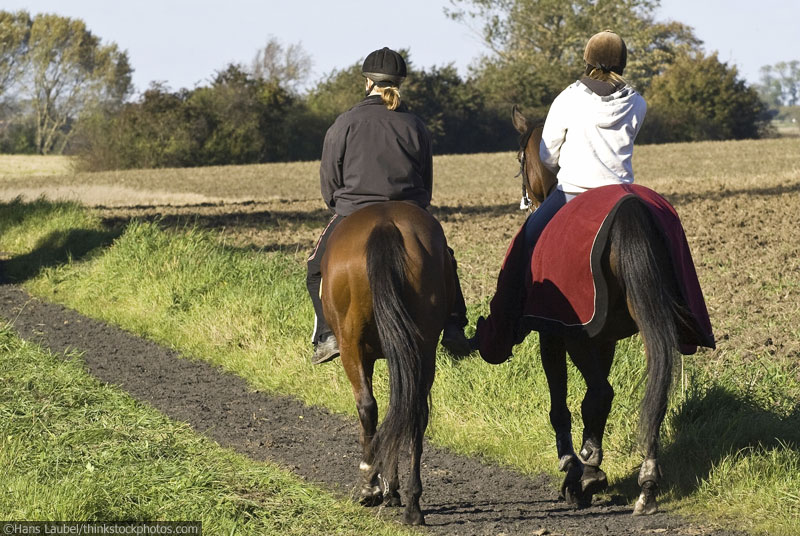Your horse has had a nice rest over the winter months and you’re ready to put him back into steady work. Finally, birds are singing, grass is growing and the spring thaw is well underway. It’s time to get back in the saddle and prepare for the riding season ahead. How do you bring your horse back to fitness after a scaled-back winter schedule?

A safe approach asks your horse for incremental increases in length or difficulty on about an every five-day cycle. This gives his body time to accommodate the new intensity before moving to the next level of effort. As you build his conditioning, increase either duration of time in the saddle or speed, but never both at the same time. Following each workout, monitor his legs for signs of stress, such as lameness, swelling or pain.
Conditioning Young Horses
For the horse that is young or untrained, you’ll need to start a conditioning program from scratch, taking the long way through the process. The same holds true for a horse that has suffered a musculoskeletal injury and/or has been laid up for a lengthy time. For the horse coming back from an injury, not only will he need to be legged up slowly, you’ll have to give deference to his previous injury so he doesn’t reinjure it. This is especially true of tendon or ligament injuries, and of joint problems. Muscle is more forgiving and once your vet gives you the go ahead, you’re likely to be able to bring your horse back with less risk of recurrence. But the other soft tissues, joints and feet need time and preparation just as you’d bring along a young or novice horse that has limited, if any, conditioning base.
Conditioning Senior Horses
The senior horse is another unique case – while this individual may have had years of conditioning, his tissues no longer respond as easily or as completely as that of a younger horse. So, more time and care should be taken to ensure that he doesn’t strain himself trying to do the job you ask. He may look like a normal horse in the prime of his life but remember that with advancing age, the elasticity in his tissues isn’t what it used to be, and his cardiovascular system may not work as efficiently. In addition, building muscle strength is going to take longer and not reach as robust a level as what you’d see with a mature, younger horse in its teens.
So, to play safe, it’s best to err on the side of caution and take a little extra time to put fitness back onto your horse. You’ll need to do your homework, getting your horse out at least 3-5 days per week and asking him to do some steady walk and trot initially; then after a couple weeks, start in with some canter work. Before you ask your horse to jump or perform any sprint or speed endeavors, be sure you have taken the time to rebuild his metabolic and structural systems so they are able to cope adequately with the exercise.
Besides also checking that your saddle and tack fit well after your horse’s idle down time, don’t forget to attend to all the fine details of routine maintenance – ensure a quality diet, implement deworming, vaccination and dental schedules, and keep up your horse’s foot care. Diligent preparation best ensures a successful season ahead.
Further Reading
Conditioning an Older Horse
Start Your Horse’s Spring Training






This is good information for youngsters and senior horses, but what about middle age horses? Like humans, horses approach middle age differently. What is the best way to get our horses (age 14-18) in shape? Thank you.
Jan, here’s what the article said to answer your question: ” This horse will be easy to bring back to steady work as long as you take a little time to let him get his feet under him again while you leg him back up. You can probably accomplish this with 4-5 days of easy riding each week at walk, trot and some canter over a 3-4 week period, with gradually increasing demands on his output.
A safe approach asks your horse for incremental increases in length or difficulty on about an every five-day cycle. This gives his body time to accommodate the new intensity before moving to the next level of effort. As you build his conditioning, increase either duration of time in the saddle or speed, but never both at the same time. Following each workout, monitor his legs for signs of stress, such as lameness, swelling or pain.”
My horses don’t get a break for winter. Poor things…
Very helpful,especially for the senior horse.
Thank you for the tips